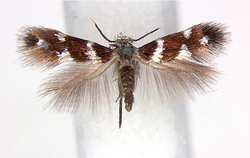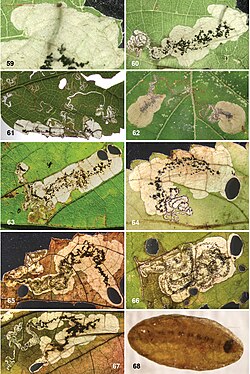Biology:Aspilanta hydrangaeella
| Aspilanta hydrangaeella | |
|---|---|

| |
| Adult female A. hydrangaeella | |
| Scientific classification | |
| Domain: | Eukaryota |
| Kingdom: | Animalia |
| Phylum: | Arthropoda |
| Class: | Insecta |
| Order: | Lepidoptera |
| Family: | Heliozelidae |
| Genus: | Aspilanta |
| Species: | A. hydrangaeella
|
| Binomial name | |
| Aspilanta hydrangaeella (Chambers, 1874)
| |
| Synonyms[1] | |
| |
Aspilanta hydrangaeella is a species of moth in the family Heliozelidae. It is found in the United States. The larvae are leaf miners that feed on hydrangea plants.[1][2][3]
Distribution
A. hydrangaeella can be found in the eastern United States, including Georgia, Illinois, Kentucky, Maryland, North Carolina, Ohio, and Tennessee .[1][2]
Description
Adult A. hydrangaeella have a wingspan of 5.0–5.8 mm (0.20–0.23 in), with each forewing measuring 2.2–2.8 mm (0.087–0.110 in) in length.[1] Externally, adult A. hydrangaeella are similar to other moths in the genus Aspilanta, but can be differentiated by their antennae – the antennae of A. hydrangaeella have noticeable white tips.[2][3]
The larvae are colorless or whitish besides their green gut contents, with a dark brown head and prothorax. Darker spots may be visible on some body segments.[1] Their primary host plant is smooth hydrangea (Hydrangea arborescens), though larvae can also be found less frequently on snowy hydrangea (Hydrangea radiata).[3]
The leaf mine begins with a long, sometimes contorted linear portion that eventually widens out into an elongate blotch or wide gallery. The frass ranges from green to black in color, and is distributed in a narrow line at the start of the mine but forms a central smear in the larger, later portion of the mine. When mature and ready to pupate, the larvae cut out a 3.5–4.5 mm (0.14–0.18 in) long case from their host leaf, leaving an elliptic hole.[1]
References
| Wikimedia Commons has media related to Aspilanta hydrangaeella. |
- ↑ 1.0 1.1 1.2 1.3 1.4 1.5 van Nieukerken, Erik J.; Eiseman, Charles S. (2020). "Splitting the leafmining shield-bearer moth genus Antispila Hübner (Lepidoptera, Heliozelidae): North American species with reduced venation placed in Aspilanta new genus, with a review of heliozelid morphology". ZooKeys (Pensoft Publishers) (957): 105–161. doi:10.3897/zookeys.957.53908. ISSN 1313-2970. PMID 32863714. Bibcode: 2020ZooK..957..105V.
- ↑ 2.0 2.1 2.2 van Nieukerken, Erik J.; Wagner, David; Baldessari, Mario; Mazzon, Luca; Angeli, Gino; Girolami, Vincenzo; Duso, Carlo; Doorenweerd, Camiel (2012). "Antispila oinophylla new species (Lepidoptera, Heliozelidae), a new North American grapevine leafminer invading Italian vineyards: taxonomy, DNA barcodes and life cycle". ZooKeys (Pensoft Publishers) (170): 29–77. doi:10.3897/zookeys.170.2617. ISSN 1313-2970. PMID 22408380. Bibcode: 2012ZooK..170...29V.
- ↑ 3.0 3.1 3.2 "Aspilanta hydrangaeella (Chambers, 1874) - No Common Name". North Carolina Division of Parks and Recreation and North Carolina Biodiversity Project. https://auth1.dpr.ncparks.gov/moths/view.php?MONA_number=243.
Wikidata ☰ {{{from}}} entry
 |


